Merhaba ve hoşgeldin!
I am excited to showcase the new content for the Ottomans. But before we get to that, I want to comment on some lessons we have learned from the development process of Lions of the North, even if we are quite happy with the final result and its release state:
- Branching missions are like seasoning: a few of them can add some interesting paths to your country. Too much and they ruin the mission tree as they are clunky to use, generate walls of text and are in general not pretty to look at.
They are also prone to script-related bugs and are too painful to maintain. Because of that, we will not have any case akin to the Teutonic Order in the future where half of the mission tree is covered in branching missions.
- Customizable government reforms like the ones of Livonia were a fun experiment, but from a script perspective a nightmare to create. It also requires the player to have Wikipedia open in order to get the government reform they desire, which is not optimal.
We liked the idea that you can customize your government reform in such a fashion, but for the future, we will instead utilize the different government tiers instead of having 15 different Tier 1 reforms for a single country.
- The new generic government reforms and tiers were exceptionally well received. Even though some reforms are still standing out as the most optimal choice, we like the diversity we see from the player base in their choice of government reforms.
For 1.35, we want to expand this aspect of the game a bit further.
- Too many “starting points” of the mission tree can be quite overwhelming for the player - especially if they are far down. While this is inevitable to happen due to the rigid structure of mission trees (and a whole new redesign of how mission trees are built would be like opening Pandora’s Box), we try to at least keep the amount of starting points to a minimum.
- The focus of previous Immersion Packs was too much on mission trees alone. While mission trees are highly popular, we think that we were investing too much time and focus on the mission tree part of a country and neglecting other parts of the gameplay experience. In 1.35, we still make sure to have interesting mission trees for the countries in focus which encourage unique playstyles, but we will also diversify from this part of the content and expand other parts of the country such as tag unique government reforms, flavor events, and even mechanics.
- Finally, mission trees and the content from Lions of the North make the content outside of the region of focus feel very outdated - even if the region’s specific update was not that long ago. The new DLC and the 1.35 update aim to change this and we try to go beyond our scope to expand the countries and regions which are not the focus of the former DLC.
With that being said, let us dive into the content for one of the most anticipated countries in EU4: the Ottoman Empire.
No country in EU4 splits the community like the Ottomans. Some say they are too easy to beat and don’t have this “final boss feeling” they desire from the game. Others claim that the Ottomans are absurdly overpowered and ruining the fun of the game.
But everyone can agree on one thing about them: despite its number of flavor events, unique mechanics and even unique special units, the Ottomans feel rather bland compared to all the other major powers of EU4, as it’s been a while since the last update on their content. 1.35 will change this.
Starting with the most obvious addition, the Ottoman mission tree:
 Be aware that all the content you see here is still very much work in progress. Nothing here is final.
Be aware that all the content you see here is still very much work in progress. Nothing here is final.EU4 starts one day after the Ottoman victory in the battle of Varna. From there onwards, they rose to become one of the most prominent great powers that shaped the world during the game's time frame. As you start your campaign, you will be greeted with the following event:

Not long after you will get another event which steers you to a path of greatness:

Hiring Urban allows you to complete the mission “The Guns of Urban”:
 Note: As you get these artillery units before tech 7 they will not be able to do any damage. So take good care of them. Of course, there is also an alternative requirement to this mission if you do not hire Urban.
Note: As you get these artillery units before tech 7 they will not be able to do any damage. So take good care of them. Of course, there is also an alternative requirement to this mission if you do not hire Urban.With these two events and their respective missions completed, the “City of World’s Desire” will be your next target:

From there on your missions will branch into five different directions.
The most left ones are about your push into Europe and claiming the true Roman title with “A True Roman Empire”:


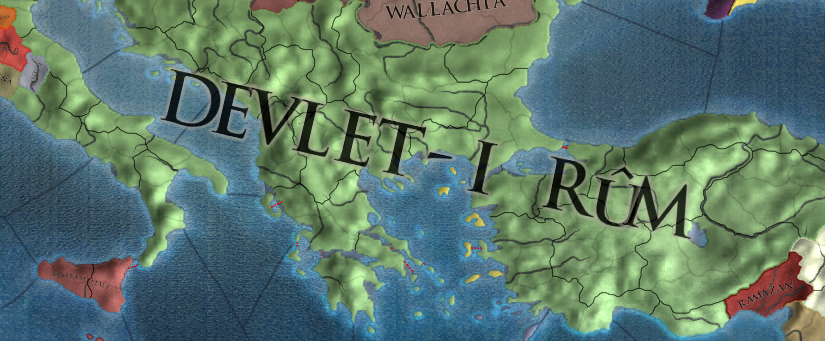
You might have noticed that the event was mentioning “Eyalets”. They are part of the new mechanics added for the Ottomans, but more to it later.
The second mission row from the left is about the Ottoman consolidation of the Balkans and the conquest of North Africa. A highlight of this row is the access to a new naval doctrine for the Ottomans if you have any subject nation in the Maghreb region:

The middle row concerns itself with the development of Constantinople as the jewel of your empire, the conquest of the Mamluks, and your push into African land.
For this part, I am returning to the previously mentioned eyalets. With the Ottoman Government, you are able to hold a new subject type called “Eyalet”. While historically, they were like provinces to the Ottoman government, I took the creative liberty to design them as a special subject type that does not take any diplomatic relations and governs the land for you.
As you go on your path of conquest, the game will trigger events for you where you can release an eyalet as one of your subjects:

 Note: all of these events have an option where you can decline the creation of an eyalet. You are not forced to have a single eyalet during your whole campaign.
Note: all of these events have an option where you can decline the creation of an eyalet. You are not forced to have a single eyalet during your whole campaign.Eyalets are not called into your wars automatically - be it from the offensive or defensive side. Instead, you have to call them by using favors (or an opinion hit if you do not have favors unlocked due to a missing DLC). Unlike other subject types, you can have favors with your subjects. It costs 20 favors to call them into an offensive war, but only 10 when you are in a defensive war.


Before you can integrate an eyalet you need to reign in it first:


You might now wonder why you would want to have eyalets around instead of just coring the conquered provinces yourself. The answer to this question are the passive benefits you gain from eyalets. Not only do they pay you vassal tax, but also provide you with 20% of their manpower and sailor pool as well as force limit. They are designed to give roughly the same amount of manpower and force limit as if you would own the provinces for yourself.
While there are roughly 8 pre-defined and scripted Eyalets you can create from events, you are still able to make your own eyalets through a special casus belli which you can fabricate in neighboring countries:
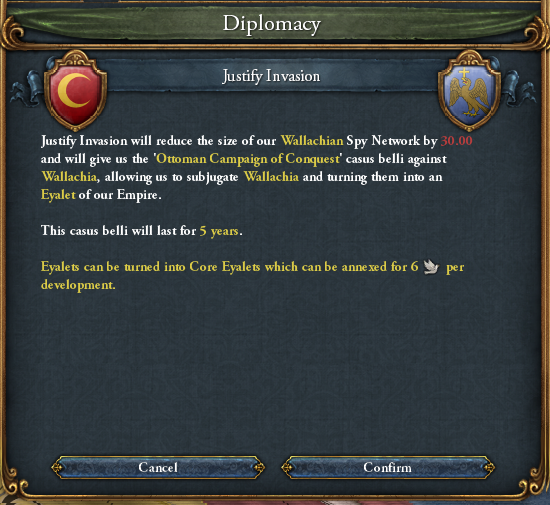

 Note: eyalets you create through the fabricated CB will not have a unique Eyalet name. But other than that they act exactly like normal eyalets.
Note: eyalets you create through the fabricated CB will not have a unique Eyalet name. But other than that they act exactly like normal eyalets.With that excursion out of the way, let us return to the war with the Mamluks. The mission “Defeat the Mamluks” will require you to conquer 6 provinces of the Mashriq part of the Mamluks:


After winning the siege of the capital of the Mamluks, the following event fires:

And for the Mamluks:

After holding their capital for three years, you get the following event:


Your new Egyptian eyalet will not be as efficient as other eyalets though due to their Mamluk administration. With the mission “The Fate of the Mamluks” you can remove this modifier from your subject.
The fourth row is about the religious path of your country. As you seize Egypt for yourself, you will also seize the Caliphate which is housed there, as well. As such, the branching missions are about going on a path of legalism or a path of mysticism. No matter which path you choose, either ending of the branching missions will be required for the “Second Islamic Golden Age”. If you manage to Unify Islam you will be able to complete this mission and gain a reward that is not only useful to you, but to every remaining Muslim country (those who were lucky enough to not hold any of the important sites).

Finally, the last row of the tree shall be a motivation to push into Persia and secure the ancient silk road. A highlight here is the reward from the mission “Imperial Fabrics”:

As the finisher of the mission tree, you get a permanent +5% Administrative Efficiency from the mission “Pax Ottomana”. Its requirements are a bit more challenging, but they play very much into the gameplay loop of the Ottomans.

That was it for the mission tree, but we are not done yet with the content for the Ottomans. With the DLC, the Ottomans gain access to two new features (next to the previously mentioned Eyalets): the Janissary Estate and Decadence.
Starting with the Janissaries:
 The icon is a placeholder. Their unique icon is a work in progress.
The icon is a placeholder. Their unique icon is a work in progress.The Janissary estate is one you will love in the early game and learn to dislike in the later phases of the game. Their initial “privileges” are more of a set of edicts you can give to them. Here is the full list of them:
 Keep in mind that none of these numbers are final. For example: the 10% Discipline for the Janissaries here are definitely on the chopping block when we come to the polishing and balancing phase of the development process.
Keep in mind that none of these numbers are final. For example: the 10% Discipline for the Janissaries here are definitely on the chopping block when we come to the polishing and balancing phase of the development process.These privileges are designed to be very powerful. However, they come at a price later on: the Janissaries themselves want their own privileges and can turn these edicts into a negative version of it or demand new privileges entirely:

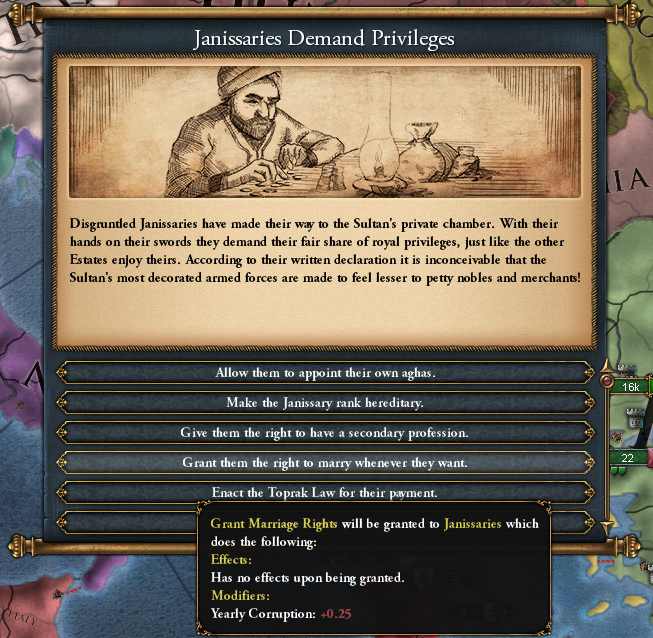
Refusing to give privileges will result in Janissary revolts which are more dangerous than normal rebels. As such, refusing them to grant these privileges can lead to your country breaking to the Janissaries.
Of course a new estate also means new agendas. The Janissaries have their own set of agendas which are inspired by the Rajput or Maratha's agendas:
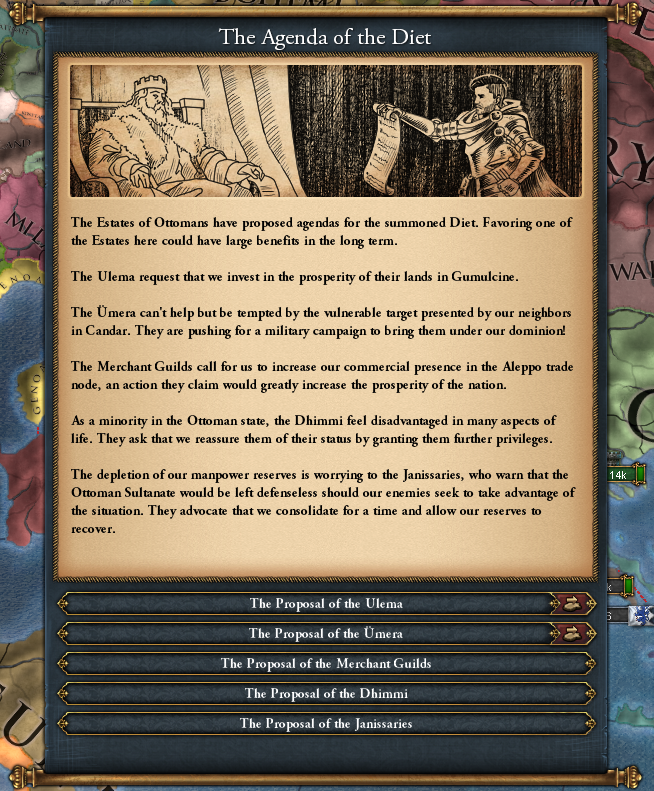 Note: with 1.35 you will be able to choose the agenda from up to 6 estates present in your country.
Note: with 1.35 you will be able to choose the agenda from up to 6 estates present in your country.Now we come to a different part of the Ottomans: the Decadence mechanic:
 Note: the UI here is very much a work in progress.
Note: the UI here is very much a work in progress.A big wish from the player base was that big empires have a way to break apart. As the Ottomans are the Number 1 subject of contention, I have decided to create a prototype of internal cohesion for the Ottomans first. Depending on how well it is received and how the game plays out with it, it might be expanded in the future.
Now, what exactly does the funny bar do? Decadence is basically a new type of measurement to get an idea of how cohesive and stable your empire is. You gain decadence from negative stability, from being bankrupt, from negative legitimacy, from Corruption, from being over Governing Capacity, from losing a war, and from a pulse event which triggers if you have over 100 Overextension.
Positive legitimacy and stability on the other hand reduce decadence, but to a slower degree.
At 100 Decadence you have to live with the following modifiers:
 Note: these numbers are NOT final.
Note: these numbers are NOT final.Historically, the power of the Ottoman Empire began to wane around 1600, its swan song being the siege of Vienna in 1683, followed by a slow decline until the Victorian period. However, for the sake of gameplay and the ability to be able to break down the Ottomans later on, they have received a set of special disasters which get unlocked when they reach 100 Decadence:



While most players (and the AI without player intervention most of the time) will avoid the disasters altogether, those who seek challenge and pain can trigger the Decadence disaster on purpose in order to unlock the missions which are about handling the many challenges of your empire.

During the Internal Power Struggle disaster, you have four disasters to deal with (or five if you are at the Age of Revolutions, the fifth one would be the normal Revolution disaster itself): “Janissary Coup”, “Eyalet Rebellion”, “Pasha Decadence” and “Plot of the Harem”.
To give a quick rundown of the disasters and their themes: the Eyalet Rebellion is, as the name suggests, about your Eyalets becoming rebellious against their overlord. This is especially the case for your Egyptian, Andalusian and Persian eyalet, which are of the opinion that their distance from Constantinople gives them every right to break away from you.


Pasha Decadence is the disaster that is the most straightforward: your provinces are getting decadent and refuse to pay you and you eliminate their rebellions. Especially the Balkans will try to break away from you.
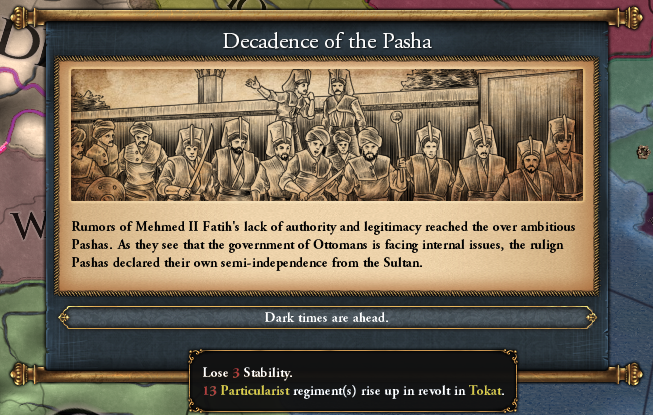

Plot of the Harem is a bit trickier as this disaster is about the internal power struggle between the Harem and the Sultan. Unlike the other disasters, this one is on an internal level.

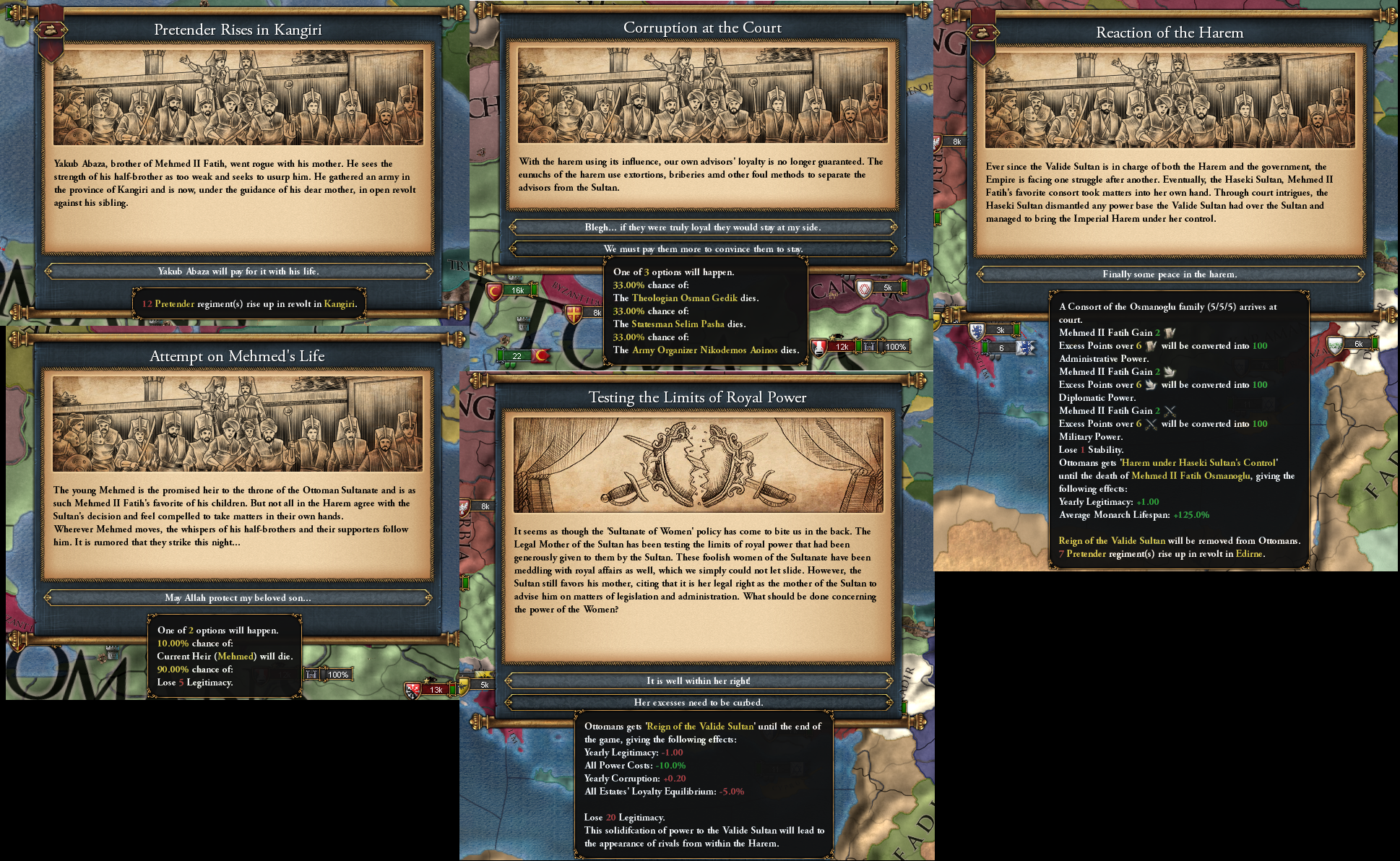
Finally, the last disaster which is by far the most impactful one: the Janissary Coup. The original disaster has received quite the overhaul as it is now part of the disaster set you have with the Decadence.
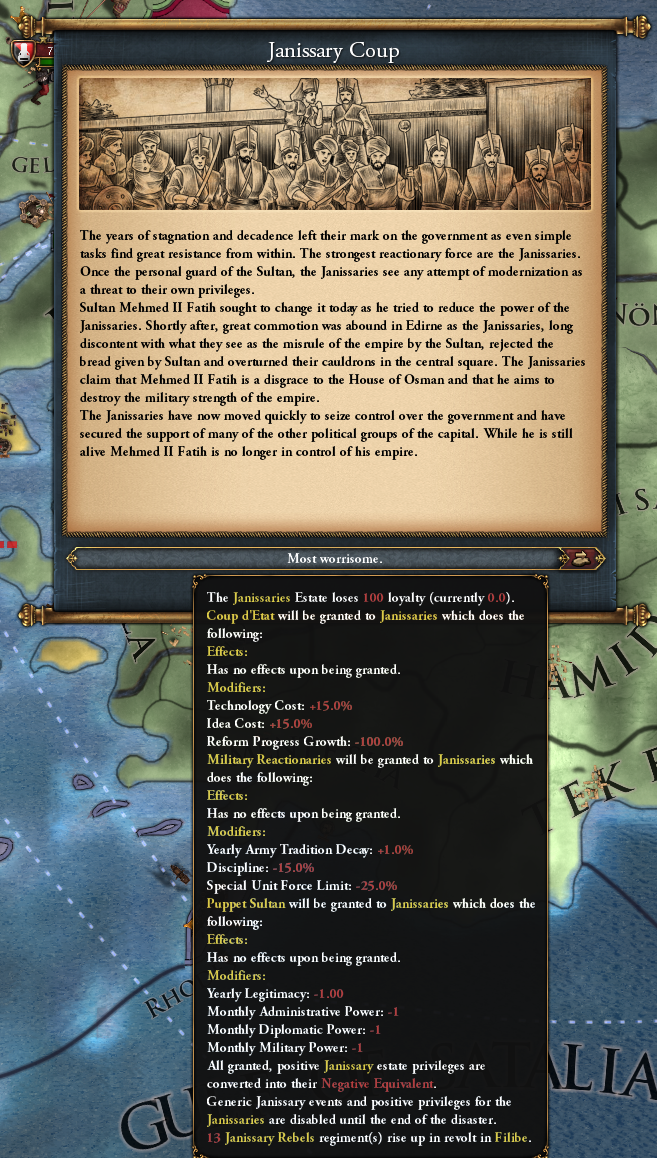
The Janissary Coup will immediately add three new privileges to your estate. This means you will have up to 9 privileges active for the Janissaries eventually.
With the mission “Handle the Janissaries” you unlock two different ways of overcoming this disaster.

You either negotiate with the Janissaries and revoke one of their privileges or you bring the fight to them and defeat them in combat. At this point I should mention that the Janissaries are more dangerous than normal rebels and have significantly more morale than your troops. Additionally, they spawn with artillery rows which means they are actually potent rebels.
Because of their strength, I have decided that you should be able to spawn the rebels on command with the “Face the Janissaries” decision instead of forcing you to engage them through a random event.
 Right now, the number of rebels you get is inflated. It will be tuned down in the coming weeks.
Right now, the number of rebels you get is inflated. It will be tuned down in the coming weeks.If you finish the disaster by slaughtering them to the last man then you can complete the mission “Mansure Army” and you get the following event:

Alternatively, you get the following mission if you complete the disaster by revoking all of the privileges:

After completing all the disaster-related missions, the “Internal Power Struggle” disaster will end and you get the following rewards for all the pain you had to deal with:
 Note: modifiers are currently mirroring the normal Ottoman Government. The main feature of this reform is the lack of Decadence.
Note: modifiers are currently mirroring the normal Ottoman Government. The main feature of this reform is the lack of Decadence.And you gain the following reward from the mission:

Now let us take a look at the last bit of Ottoman content: events and reforms. First thing first: the Devshirme System has been moved from being a decision to become its very own reform in Tier 2:
 Note: the influence color should be yellow.
Note: the influence color should be yellow.With this government reform you unlock the following mechanics:

And yes, you see it right. The three-button reforms are back as we want to give the nations in our scope features and mechanics which prevail for the country long after you are done with your mission tree already.
The tier 3 reform:

And a few flavor events which you will encounter during your campaign:









At last, some quick notes about the other states in Anatolia. Due to how Decadence works, I have decided to add a unique government reform for Rûm which does not have the Decadence mechanic.

Turkish minor states now also start with the Beylik government reform:

And a unique naval doctrine for all Turkish nations:

That was it for today. I thank you all for your attention! Next week we will return to Far East Asia with PDX Big Boss as we take a closer look at the content for Japan!
For fun, we also wanted to share another special episode of Chapel Comic:



































































